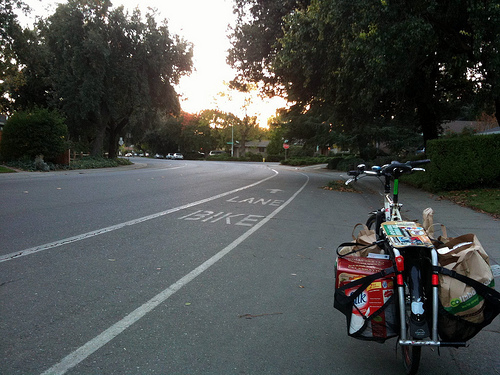We can make our roads a lot more bike-friendly. Here’s how
For the past 40 years, planners have thought the best way to deal with cyclists was to treat them like vehicles. But that policy has left only “fearless” cyclists using the roads. Bikes don’t have to remain a rarely-used alternative. We can change the paradigm.
Today, relatively few people commute by bike, though with new protected bike facilities in many cities, that’s starting to change. At StreetsCamp, Jess Zdeb of Toole Design showed how to appeal to a broader base.
“The story of the way we design our streets and neighborhoods can be changed” #streetscamp
— Betsy Emmons (@ekemmons) June 20, 2015
Zdeb taught attendees of her session about the past, present, and future of bicycle infrastructure.
While these days, America is only just now cottoning on to the idea of the protected bike intersection (several cities are currently in a race to install the first one in the United States), the concept actually dates back to the 1970s.
Mind blown most so far by 1972 California protected intersection design guide #streetscamp @ggwash @tooledesign pic.twitter.com/7JR5uouxfU
— Zack D. (@mrpresident1776) June 20, 2015
John Forester introduced the idea of “vehicular cycling,” or treating cyclists as drivers. This led to the world we live in today, where “strong and fearless” riders are often the only ones brave enough to venture out on the roads, and we have only a 1% mode share for cyclists.
Zdeb shows the “4 types of cyclists.” How do we cater to the “interested but concerned”? #streetscamp pic.twitter.com/b1Kpyn5CUc
— Matt' Johnson, AICP (@Tracktwentynine) June 20, 2015Important to separate mass, volume, and speed. @jesszdeb talking better bike infrastructure at #streetscamp pic.twitter.com/iYXgjJFjRv
— Marco Sánchez (@MarcoASanchez) June 20, 2015
Zdeb then introduced a modern method of bicycle network analysis, based on how hard or stressful it is to ride in a given area. The Level of Traffic Stress methodology ranks streets based on the stress level that cyclists experience. Montgomery County’s Bike Plan, currently underway, is using this methodology.
Level of bike stress in Ft Collins,CO. #streetscamp pic.twitter.com/TDP9Uty0fr
— myasjogren (@myasjogren) June 20, 2015
Zdeb pointed out how important it can be to consider pilot projects when proposing new infrastructure. They can help residents realize what the results of these projects would actually do for their communities. Recently, Toole Design helped facilitate a demonstration project in Columbia that showed how effective protected bike lanes could be in the community. That could help Columbia decide to build a permanent facility like this.
Want to see changes in your streets? Demonstration projects are one way to make that happen. Get started! #streetscamp #TacticalUrbanism
— Angela Zimmermann (@angzimmermann) June 20, 2015Demonstration project in Columbia, MD provides a safer space for biking. #streetscamp #the horizonfound pic.twitter.com/vV8eG2H26t
— myasjogren (@myasjogren) June 20, 2015
Zdeb says if we really want to get the majority of people to bike, we have to install protected infrastructure. Treating cyclists like vehicles — and exposing them to high levels of traffic stress — doesn’t appeal to most people.
Why are we putting sharrows on 6-lane arterials and thinking it will change behavior? #streetscamp
— Dan Emerine (@DJEinDC) June 20, 2015Sharrows are literally pictures of people on bikes, repeatedly being run over by automobiles. #streetscamp
— Mary Lauran Hall (@MaryLauran) June 20, 2015
You may not believe it, but after WWII, the Dutch rebuilt their cities to be a lot like those in the US. It was only after they decided that too many people were dying on those kinds of roads that they started separating bicycle infrastructure and became the cycling haven that we know today. The change saved a lot of lives.
Better street design saves lives. #streetscamp pic.twitter.com/aS1PWcwsIU
— Dan Emerine (@DJEinDC) June 20, 2015
Those of us in the States could have made a similar decision, but we opted to continue driving. Zdeb summed it up with her most-tweeted comment of the whole presentation:
Ah, the crux of the issue. #streetscamp pic.twitter.com/VayhnVWPSz
— Matt' Johnson, AICP (@Tracktwentynine) June 20, 2015
Cities to watch in the future for big bicycle projects, according to Zdeb, include Seattle, Boston and Cambridge, and cities participating in the Vision Zero Initiative.
@JCAyala2013 Boston's protected bike lanes proposal. #streetscamp #pg pic.twitter.com/yHAHYaeaYQ
— JC Ayala (@JCAyala2013) June 20, 2015
